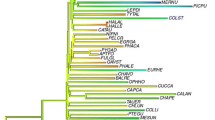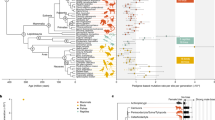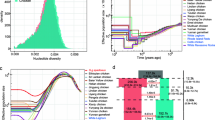Abstract
Positive correlation between recombination rate and nucleotide diversity has been observed in a wide variety of eukaryotes on megabase scale. On the basis of genome-wide chicken genetic variation map generated by comparing three domestic breeds with wild ancestor and the positions of markers on the genetic linkage map, we found that SNPs rates were similar for all chromosomes while the recombination rates increased in micro chromosomes. In other words no correlation exists in chromosome size. Nevertheless, when we scanned the genome by calculating the values of each characteristic within non-overlapping windows, instead of single value for each chromosomes, the nucleotide diversity was found to be significantly correlated with the recombination rate (r=0.27, P<0.0005). Furthermore, the significant association not only existed between these two features, but also existed between all 6 pairwise combinations of nucleotide diversity, recombination rate, GC content and average gene length. This co-variation is very meaningful for the studies of sequence evolution.
Similar content being viewed by others
References
Begun D J, Aquadro C F. Levels of naturally occurring DNA polymorphism correlate with recombination rates in D. melanogaster. Nature, 1992, 356(6369): 519–520
Cutter A D, Payseur B A. Selection at linked sites in the partial selfer Caenorhabditis elegans. Mol Biol Evol, 2003, 20(5): 665–673
Tenaillon M I, Sawkins M C, Long A D, et al. Patterns of DNA sequence polymorphism along chromosome 1 of maize (Zea mays ssp. mays L.). Proc Natl Acad Sci USA, 2001, 98(16): 9161–9166
Nachman M W. Patterns of DNA variability at X-linked loci in Mus domesticus. Genetics, 1997, 147(3): 1303–1316
Waterston R H, Lindblad-Toh K, Birney E, et al. Initial sequencing and comparative analysis of the mouse genome. Nature, 2002, 420(6915): 520–562
Nachman M W. Single nucleotide polymorphisms and recombination rate in humans. Trends Genet, 2001, 17(9): 481–485
Lercher M J, Hurst L D. Human SNP variability and mutation rate are higher in regions of high recombination. Trends Genet, 2002, 18(7): 337–340
Hudson R R. How can the low levels of DNA sequence variation in regions of the Drosophila genome with low recombination rates be explained? Proc Natl Acad Sci USA, 1994, 91(15): 6815–6818
Hellmann I, Ebersberger I, Ptak S E, et al. A neutral explanation for the correlation of diversity with recombination rates in humans. Am J Hum Genet, 2003, 72(6): 1527–1535
Wiehe T H, Stephan W. Analysis of a genetic hitchhiking model, and its application to DNA polymorphism data from Drosophila melanogaster. Mol Biol Evol, 1993, 10(4): 842–854
Charlesworth B, Morgan M T, Charlesworth D. The effect of deleterious mutations on neutral molecular variation. Genetics, 1993, 134(4): 1289–1303
Wong G K, Liu B, Wang J, et al. A genetic variation map for chicken with 2.8 million singlenucleotide polymorphisms. Nature, 2004, 432(7018): 717–722
Hillier L W, Miller W, Birney E, et al. Sequence and comparative analysis of the chicken genome provide unique perspectives on vertebrate evolution. Nature, 2004, 432(7018): 695–716
Groenen M A, Cheng H H, Bumstead N, et al. A consensus linkage map of the chicken genome. Genome Res, 2000, 10(1): 137–147
Schmid M, Nanda I, Guttenbach M, et al. First report on chicken genes and chromosomes 2000. Cytogenet Cell Genet, 2000, 90(3–4): 169–218
Romanov M N, Price J A, Dodgson J B. Integration of animal linkage and BAC contig maps using overgo hybridization. Cytogenet Genome Res, 2003, 102(1–4): 277–281
Ewing B, Hillier L, Wendl M C, et al. Base-calling of automated sequencer traces using phred. I. Accuracy assessment. Genome Res, 1998, 8: 175–185
Ewing B, Green P. Base-calling of automated sequencer traces using phred. II. Error probabilities. Genome Res, 1998, 8: 186–194
Wang J, He X M, Ruan J, et al. ChickVD: A sequence variation database for the chicken genome. Nucleic Acids Res, 2005, 33(Database issue): 438–441
Axelsson E, Webser M T, Smith N G, et al. Comparison of the chicken and turkey genomes reveals a higher rate of nucleotide divergence on microchromosomes than macrochromosomes. Genome Res, 2005, 15(1): 120–125
Eyre-Walker A, Hurst L D. The evolution of isochores. Nat Rev Genet, 2001, 2(7): 549–555
Bernardi G. Isochores and the evolutionary genomics of vertebrates. Gene, 2000, 241(1): 3–17
Marais G. Biased gene conversion: implications for genome and sex evolution. Trends Genet, 2003, 19(6): 330–338
Lander E S, Linton L M, Birren B, et al. Initial sequencing and analysis of the human genome. Nature, 2001, 409(6822): 860–921
Author information
Authors and Affiliations
Corresponding author
Additional information
Contributed equally to this work
Supported by the Chinese Academy of Sciences (Grant Nos. GJHZ0701-6 and KSCX2-YW-N-023), Ministry of Science and Technology under high-tech program 863 (Grant Nos. 2006AA10A121 and 2006AA02Z334), Chinese 973 Program (Grant Nos. 2007CB815703 and 2007CB815705), Ministry of Education (Grant No. XXBKYHT2006001), National Natural Science Foundation of China (Grant Nos. 30725008, 90608010, 90403130 and 90612019), and Chinese Municipal Science and Technology Commission (Grant No. D07030200740000)
About this article
Cite this article
Fang, L., Ye, J., Li, N. et al. Positive correlation between recombination rate and nucleotide diversity is shown under domestication selection in the chicken genome. Chin. Sci. Bull. 53, 746–750 (2008). https://doi.org/10.1007/s11434-008-0159-y
Received:
Accepted:
Published:
Issue Date:
DOI: https://doi.org/10.1007/s11434-008-0159-y




